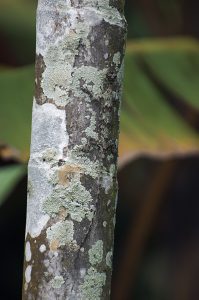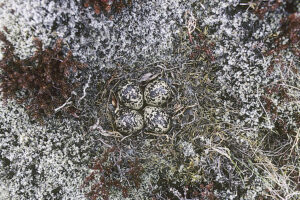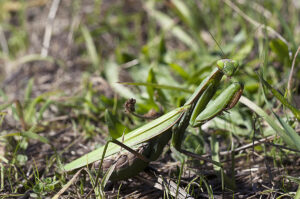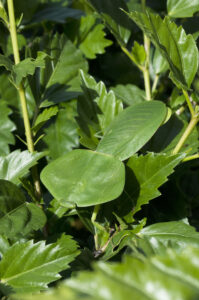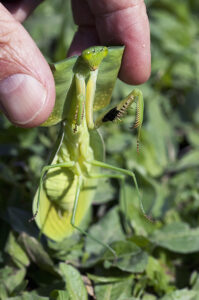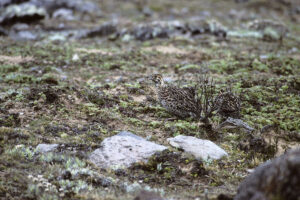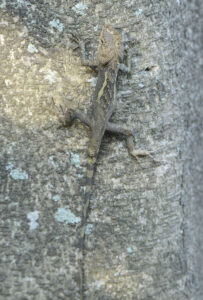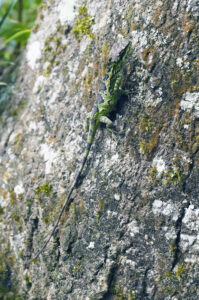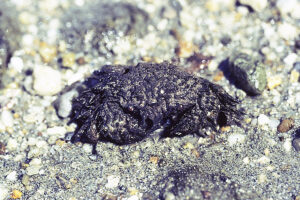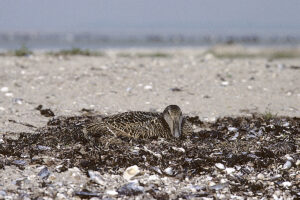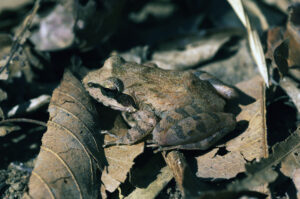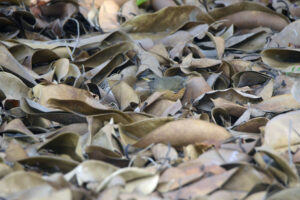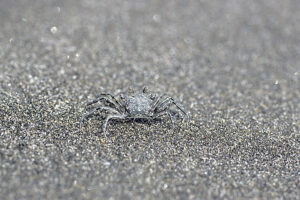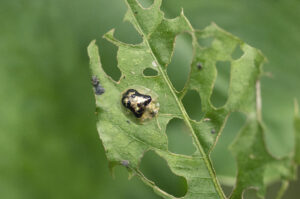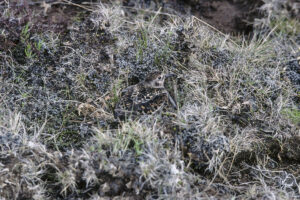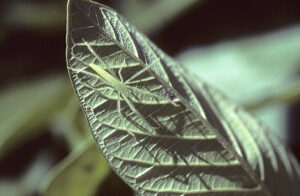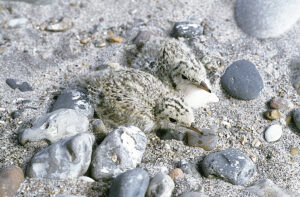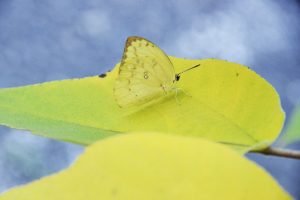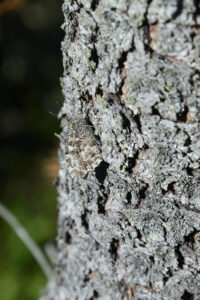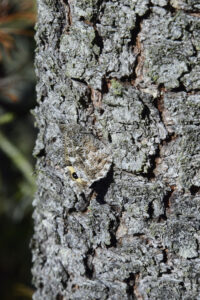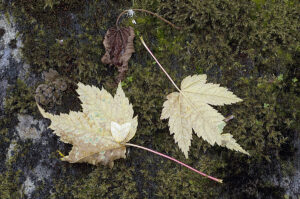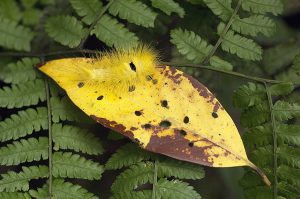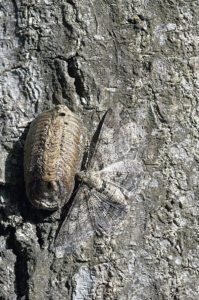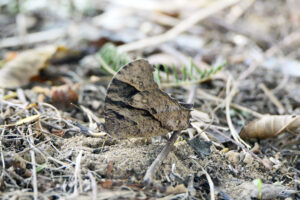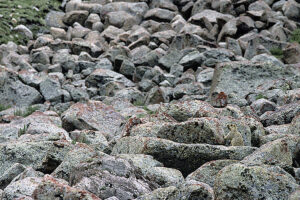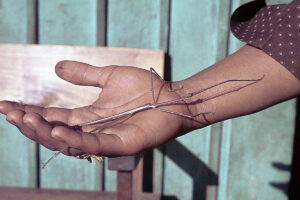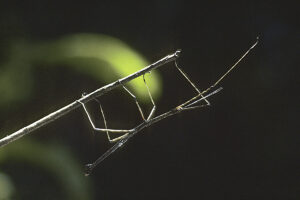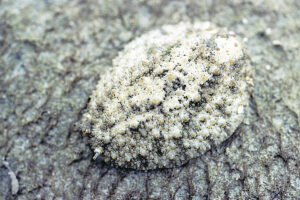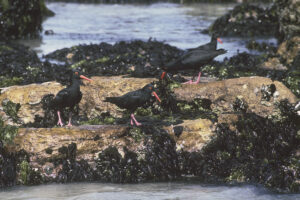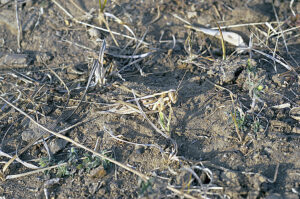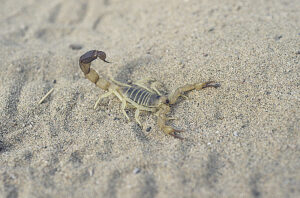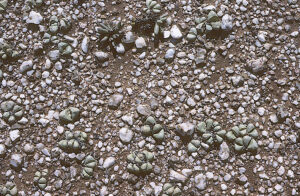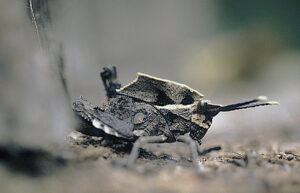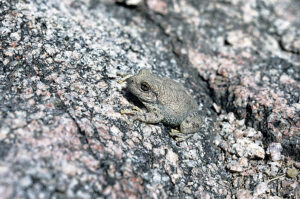Camouflage in nature
Gliding lizards (Draco) is a genus of unique agamids, containing about 40 species, all but one restricted to Indochina, Malaysia, the Philippines, and Indonesia. A single species is found in south-western India.
These animals are also called flying lizards, which is not a very descriptive name, as they are not able to truly fly, but glide from one tree to another by spreading out their ribs, which are connected by a wing-like membrane, called a patagia.
The generic name is a Latinized version of Ancient Greek drakon (‘dragon’).
Formerly, it was believed that the Javan gliding lizard (D. volans) had a wide distribution in Indochina, Malaysia, Indonesia, and the Philippines, but today it is considered restricted to Java and Bali.
This Javan gliding lizard is almost invisible, sitting on the lichen-covered trunk of a betel palm (Areca catechu), Bali, Indonesia. – This palm is described on the page Nature: Nature’s patterns. (Photo copyright © by Kaj Halberg)
The Eurasian golden plover (Pluvialis apricaria) breeds in Arctic and Northern Temperate areas, from Iceland and Scotland in the west, across northern Europe to central Siberia. Further east, it is replaced by the Pacific golden plover (P. fulva), whose breeding area reaches western Alaska, and in the remaining part of North America by the American golden plover (P. dominica). All three are very similar, with golden-speckled back and black breast in breeding plumage.
The generic name is from the Latin pluvia (‘rain’). Formerly, it was believed that when golden plovers would flock, it was a sign of imminent rain. In Icelandic folklore, the arrival of the first golden plover means that spring has come.
This nest of a Eurasian golden plover at Þingvellir, Iceland, is very well camouflaged, as the pattern on the eggs resemble the straw and lichens, surrounding the nest. (Photo copyright © by Kaj Halberg)
Praying mantises are a very successful group of insects, comprising more than 2,400 species, distributed worldwide in tropical and subtropical areas. They are ambush hunters, sitting motionless in the vegetation, waiting for suitable prey to approach. Their forelegs are enlarged and hooked, adapted for snatching and holding prey. As they sit there with their forelegs folded, their posture is not unlike a praying person, which gave rise to their common name. However, preying mantis would be a more proper name!
This Californian praying mantis (Stagmomantis californica), encountered in Sinkyone Wilderness State Park, California, sits motionless in the vegetation, waiting for prey to pass by. (Photo copyright © by Kaj Halberg)
Praying mantises are often remarkably well camouflaged, resembling a withered grass stem, like this one in Helambu, Nepal. (Photo copyright © by Kaj Halberg)
Other praying mantises resemble leaves, like this one, of the genus Choeradodis, encountered in Cordillera de Tilarán, Costa Rica. (Photos copyright © by Kaj Halberg)
The moorland francolin (Scleroptila psilolaema) is endemic to Ethiopia, where it lives in highland moorland. Its speckled plumage is a perfect adaptation to its habitat.
Moorland francolins, Sanetti Plateau, Bale Mountains National Park, Ethiopia. (Photo copyright © by Kaj Halberg)
Swinhoe’s japalure (Diploderma swinhonis, previously Japalura swinhonis), is a lizard in the family Agamidae, native to Taiwan. It feeds on arthropods and other small animals, living in forests, shrubberies, and city parks. It is often perched on trees where sunlight is present.
It was named in honour of British biologist Robert Swinhoe (1836-1877) who, in 1860, became the first European consular representative to Taiwan. He discovered many new species, and four mammals and 15 birds are also named after him.
This Swinhoe’s japalure is well camouflaged on a tree trunk, Taichung, Taiwan. (Photo copyright © by Kaj Halberg)
The short-legged japalure (Diploderma brevipes, previously Japalura brevipes) is another japalure, which is endemic to Taiwan, where it lives in montane forests, at elevations between about 1,000 and 2,200 m. Its total length is about 25 cm, of which the tail is 15 cm.
This short-legged japalure blends well with a lichen-covered tree trunk, Malabang National Forest, Hsinshu, Taiwan. (Photo copyright © by Kaj Halberg)
This moon crab of the genus Matuta is completely covered in a growth of sea algae, making it almost invisible, Mindoro, Philippines. (Photo copyright © by Kaj Halberg)
The common eider (Somateria mollissima) has an almost circumpolar distribution, found along Arctic and Northern Temperate coasts, from the Kola Peninsula westwards across Scandinavia, the northern British Isles, Iceland, Greenland, Maine, Arctic Canada, and Alaska, to the extreme eastern Siberia.
The nest of this species is built near the seashore, lined with down, which the female plucks from her own breast. This soft down has been harvested by people for hundreds of years, used as filling in pillows, quilts, and jackets. This harvesting was done with no harm to the birds, as it took place when the ducklings had left the nest.
The scientific name is derived from the Greek soma (‘body’) and erion (‘wool’), and the Latin mollissimus (‘very soft indeed’), all referring to soft down feathers. The name eider is a corruption of the Icelandic name of the bird, æðarfugl, which is derived from the Old Norse æðr.
In Northumberland, southern Scotland, the eider duck is known as the cuddy duck, named after Saint Cuthbert (c. 634-687), a monk, bishop, and hermit of the early Northumbrian Celtic church. While on the Farne Islands, he instigated special laws to protect the ducks and other seabirds, nesting on these islands.
The mottled plumage of this incubating female eider, photographed on the Mågeøerne Islets, Funen, Denmark, blends in very well with the washed-up seaweeds, in which she has placed her nest. (Photo copyright © by Kaj Halberg)
Bush frogs of the genus Pseudophilautus, comprising about 80 species, belong to the family Rhacophoridae. This genus is restricted to Sri Lanka and the Western Ghats of southern India. Many species are highly endangered, mainly due to habitat destruction, and about 13 species have already become extinct.
The rare Amboli bush frog (Pseudophilautus amboli) is endemic to the Western Ghats, found from southern Maharashtra southwards to Karnataka. It is small, the largest specimens measuring about 3.7 cm. It lives in forests and is critically endangered due to habitat destruction and fragmentation.
This Amboli bush frog is well camouflaged among withered leaves on the forest floor, Mahaveer Wildlife Sanctuary, Goa. (Photo copyright © by Kaj Halberg)
The brown-headed thrush (Turdus chrysolaus) is endemic to East Asia, breeding from Sakhalin and the Kuril Islands southwards to central Honshu, Japan, spending the winter in southern Japan, Taiwan, and the Philippines. It is mainly of a warm brown colour, with reddish breast and white central belly. The male has blackish-brown head and throat, whereas the female has a whitish throat with black vertical stripes.
This female brown-headed thrush is very well camouflaged, feeding among dead leaves, Tunghai University Park, Taichung, Taiwan. (Photo copyright © by Kaj Halberg)
This tiny crab blends in very well with the grey sand on a beach, Bali, Indonesia. (Photo copyright © by Kaj Halberg)
Tortoise beetles, subfamily Cassidinae, are a large group of more than 3,000 species, which resemble miniature turtles due to the forward and sideways extensions of their body. They measure between 5 and 12 mm in length, and the larvae are spiny. Both adults and larvae eat leaves, and some species are regarded as agricultural pests.
One genus in the subfamily is Cassida, containing more than 430 species, distributed in the Old World. The generic name is derived from the Latin cassis (‘metal helmet’).
The Japanese turtle beetle (Cassida japana) is distributed in Japan, China, Taiwan, and Indochina.
This Japanese turtle beetle (Cassida japana), sitting on a leaf of an Achyranthes species, looks remarkably like a bird dropping, Malabang National Forest, Taiwan. It has eaten part of the leaf. (Photo copyright © by Kaj Halberg)
The purple sandpiper (Calidris maritima) breeds in Arctic mountains in northern Canada, from Banks Island southwards to Ellesmere and Baffin Islands, in Greenland, Iceland, Jan Mayen, Bear Island, Svalbard, along the Scandinavian mountain range, northern Norway, extreme north-western Russia, Franz Josef Land, Novaya and Severnaya Zemlya, and on the Taimyr Peninsula.
It spends the winter months along shores of north-western and western Europe, southwards to Portugal, in extreme southern Greenland, and along the North American Atlantic Coast, southwards to South Carolina.
The specific name is Latin, meaning ‘living at the sea’, derived from mare (‘sea’). In winter, the bird is usually observed along coasts.
From a distance, this incubating purple sandpiper is almost impossible to spot among the withered grass on Selvogsheiði Moor, southern Iceland. I only found this nest, because I observed the bird from my car, when it was relieving its incubating mate. (Photo copyright © by Kaj Halberg)
This thin, green spider, probably a species of Matidia, was observed near Banawe, northern Luzon, Philippines. It long legs resemble the nerves on the underside of the leaf, on which it is sitting. (Photo copyright © by Kaj Halberg)
The little tern (Sternula albifrons) has a very wide breeding distribution, with main strongholds in west-central Asia and the Far East, and with scattered populations in Europe, western Africa, Indonesia, the Philippines, and New Guinea. During the 20th Century, most European populations declined drastically due to habitat loss, pollution, and human disturbance.
I nearly stepped on these juvenile little terns, before I noticed them, flattening themselves among pebbles, Nissum Fjord, Jutland, Denmark. (Photo copyright © by Kaj Halberg)
Butterflies and moths, and their caterpillars, are often well camouflaged.
The lemon emigrant (Catopsilia pomona), which belongs to the family Pieridae, is widely distributed, from the eastern Himalaya eastwards to eastern China, Taiwan, and Japan, and thence southwards through Indochina, Malaysia, Indonesia, and the Philippines to Australia and islands in the Pacific. The name emigrant alludes to its migratory habit.
This lemon emigrant is well camouflaged on a winter leaf of paper mulberry (Broussonetia papyrifera), Taichung, Taiwan. This tree is presented on the page Nature: Invasive species. (Photo copyright © by Kaj Halberg)
The grayling (Hipparchia semele), of the family Nymphalidae, is found all over Europe, predominantly in coastal areas, inland populations sometimes reaching elevations up to about 2,000 m. Its cryptic colours on the underwing, mainly grey and brown, make them very hard to spot, when they sit on lichen-covered tree trunks, or in sandy areas. In case it feels threatened, it will suddenly flash the eyespot on the upper wing to confuse the predator.
Grayling, sitting on the trunk of a lodgepole pine (Pinus contorta), Thy, Denmark. (Photos copyright © by Kaj Halberg)
This moth is almost invisible, sitting on a fallen leaf of a tail-leaved maple (Acer caudatum), Tharepati, Helambu, Nepal. (Photo copyright © by Kaj Halberg)
Sitting on a yellow leaf, this hairy caterpillar is very well camouflaged. Note the black spot on its body, resembling a hole in the leaf. – Malabang National Forest, Hsinchu, Taiwan. (Photo copyright © by Kaj Halberg)
An almost invisible moth, sitting on bark next to a cocoon, Chingshuian Recreation Area, Taiwan. (Photo copyright © by Kaj Halberg)
The peacock pansy (Junonia almana) is distributed from India and Sri Lanka eastwards to China, Taiwan, and Japan, and thence southwards to Indonesia. It is very common, living in a wide variety of habitats up to altitudes around 1,000 m. It is one among c. 33 species of this genus, which belongs to the huge brush-foot family (Nymphalidae).
The underside of this peacock pansy blends very well with the soil it is sitting on, Taichung, Taiwan. (Photo copyright © by Kaj Halberg)
Marmots (Marmota) are 15 species of giant squirrels, which are distributed in central and southern Europe, western and central Asia, and North America. These animals live in underground dens, and, with the exception of the American woodchuck, or groundhog (Marmota monax), which may live in forests, they are restricted to grasslands. Some species are presented on the page Animals – Mammals: Squirrels.
Himalayan marmot (M. himalayana) is found at altitudes between 3,500 and 5,200 m, throughout the Himalaya and on the Tibetan Plateau.
This Himalayan marmot is surveying its domain among lichen-covered boulders in the Markha Valley, Ladakh, India, blending in very well with the surroundings. (Photo copyright © by Kaj Halberg)
As their name implies, stick insects, also called walking sticks, resemble sticks, or withered grass stems, making them difficult for predators to spot. These animals, which belong to the order Phasmatodea, are found on all continents, except Antarctica, with the highest diversity in the Tropics.
Stick insects can grow fairly large, as this one in Sumatra, Indonesia. The largest species, found in Borneo, has a body length up to 35 cm. (Photo copyright © by Kaj Halberg)
This stick insect was encountered in Rondo Forest, southern Tanzania. (Photo copyright © by Kaj Halberg)
This extremely well camouflaged sea slug is rasping off algae from the surface of a rock, Pulau Kapas Island, Malaysia. (Photo copyright © by Kaj Halberg)
The African oystercatcher (Haematopus moquini) is restricted to coasts along Namibia, South Africa, and southern Mozambique. The specific name was given in honour of French naturalist Alfred Moquin-Tandon (1804-1863) who was initially professor of zoology in Marseille, later professor of botany and director of the botanical gardens at Toulouse, and from 1853 director of the botanical garden and the scientific academy in Paris.
These African oystercatchers blend very well with dark seaweeds, growing on rocks, Muizenberg, near Cape Town, South Africa. (Photo copyright © by Kaj Halberg)
This grasshopper in Bagan, Myanmar, resembles the withered grass around it. Note the red mites on its body. (Photo copyright © by Kaj Halberg)
Scorpions are predatory animals, characterized by a pair of so-called pedipalps, with which they grab their prey, and their tail, often carried in a curve over the back, ending in a venomous stinger. Scorpions vary enormously in size, from Typhlochactas mitchelli, which is only 9 mm long, to Heterometrus swammerdami, which can grow to 23 cm. (Source: Guinness Book of Records)
Yellow scorpion in yellow sand. – I found it one morning, hidden under my bedding, during a camel safari into the Thar Desert, Rajasthan, India. My adventures in this desert are related on the page Travel episodes – India 2003: Camel safari in the Thar Desert. (Photo copyright © by Kaj Halberg)
Plants of the genus Lithops, of the ice-plant family (Aizoaceae), remarkably resemble the pebbles, among which they grow. This genus, comprising about 37 species, is confined to South Africa, Namibia, and Botswana. The generic name is from the Greek lithos (‘stone’) and ops (‘face’), referring to the similarity of these plants to small stones. Popular names include living stones and pebble plants.
This species of Lithops was photographed on Knersvlakte (‘Grinding Plain’), near Vanrhynsdorp, South Africa. (Photo copyright © by Kaj Halberg)
This grasshopper in Rondo Forest, southern Tanzania, greatly resembles a withered leaf. (Photo copyright © by Kaj Halberg)
As its name implies, the canyon tree frog (Dryophytes arenicolor) lives in rocky areas. It is distributed in south-western United States, from Colorado, Utah, Arizona, New Mexico, and Texas southwards to the Mexican states Michoacán, México, Guanajuato, Guerrero, and Oaxaca.
This canyon tree frog blends in well with a rock, Grand Canyon, Arizona. (Photo copyright © by Kaj Halberg)
(Uploaded February 2018)
(Latest update February 2024)
